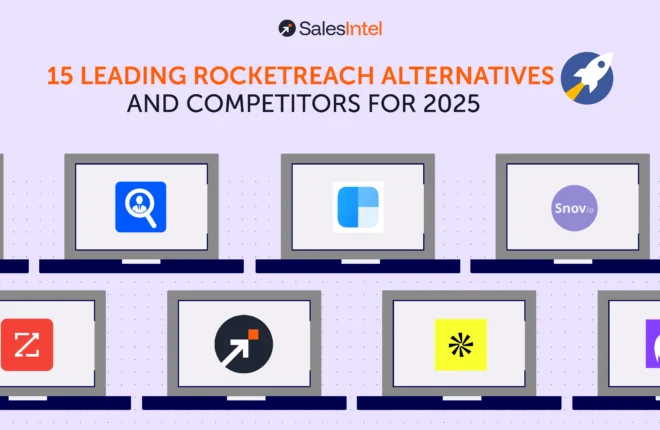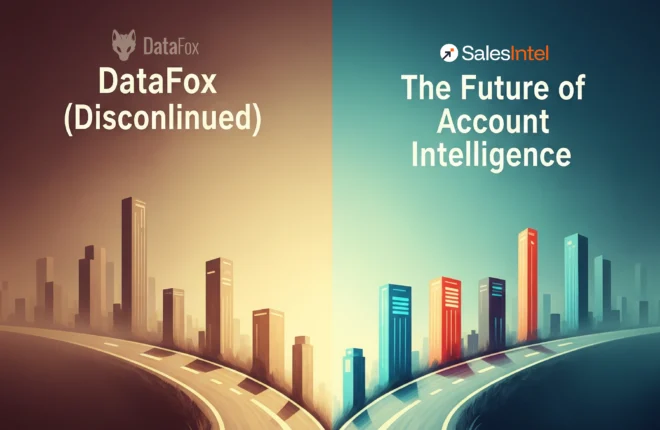Your email database isn’t static; it degrades over time as contacts change jobs, opt-out of your communications, or abandon old email addresses. As a marketer, maintaining a fresh and active email list is crucial to sustaining growth and engagement. While purchasing email lists might seem like a quick fix, it often leads to poor results and can damage your sender reputation.
In this blog post, we’ll explore high-quality, sustainable strategies to grow your email database. These methods will help you build a robust list of subscribers who are genuinely interested in your content and more likely to engage with your business, driving both sales and growth.
B2B Lead Generation Database: What Is It?
When it comes to lead generation, you might hear the terms “lead list” and “lead generation database” used interchangeably, but there’s a subtle difference.
A lead list is essentially a collection of potential customer contacts, including their names and email addresses, gathered through various opt-in methods. It’s a straightforward compilation of who might be interested in your business.
Conversely, a lead generation database is more comprehensive. It encompasses not just contact information but also detailed data on each prospect. This can include demographics, preferences, past interactions, purchase history, and more, providing a richer, more actionable resource for your marketing efforts.
What Information Does a B2B Lead Generation Database Contain?
No matter which platform you use to manage your leads, these are the key types of information typically stored in a B2B lead generation database:
- Demographic Information:
This includes basic details such as age, gender, and geographic location. For B2B, it might also include job titles, company size, and industry sector.
- Contact Information:
Beyond just email addresses and names, this can also include phone numbers, LinkedIn profiles, and mailing addresses.
- Behavioral Data:
Tracks interactions with your website or landing pages, such as pages visited, time spent on each page, and products or services viewed. It also includes responses to previous marketing campaigns, like email opens, clicks, and conversions.
- Segmentation Data:
Labels or tags used to categorize leads based on specific criteria, such as industry, job role, purchase readiness, or source of the lead (e.g., webinar attendee, whitepaper download).
- Preferences and Interests:
Details about what type of content the prospect prefers, how frequently they want to receive communication, and their specific areas of interest or need within your product/service offerings.
- Purchase Behavior:
Historical data on purchases, including what was bought, order size, frequency of purchases, and transaction history.
- Opt-Out Information:
Records of those who have unsubscribed from your communications, including any provided reasons for opting out, which can offer insights into areas for improvement.
By maintaining a robust lead generation database, you can tailor your marketing strategies more effectively, delivering personalized experiences that meet each prospect’s unique needs and preferences. This approach not only enhances engagement but also improves conversion rates and fosters long-term customer relationships.
Email databases are crucial for modern marketing strategies, serving as centralized repositories for subscriber information. They provide the essential data needed to craft effective marketing campaigns and tailor communications to specific audiences.
Areas where using email database can be a game changer:
- Efficient Campaign Management:
Centralizing subscriber information streamlines the process of planning and executing email campaigns, saving time and resources.
2. Behavioral Insights:
By leveraging subscriber behavior and purchasing history data, you can create more targeted and effective campaigns, ultimately increasing sales and revenue.
3. Enhanced Engagement:
Personalized content tailored to subscriber preferences leads to higher engagement and conversion rates.
4. Precise Segmentation:
Databases enable you to segment your audience based on various criteria, allowing for more focused and relevant messaging.
5. Compliance with Regulations:
Maintaining an organized email database ensures compliance with data regulations like the General Data Protection Regulation (GDPR), protecting both your business and subscribers.
6. Optimized ROI:
Data-driven insights from email databases help optimize campaigns, improving overall return on investment. Research has shown that email marketing yields an average ROI of $44 for every $1 spent (WPBeginner).
7. Continuous Improvement:
Access to detailed performance metrics allows you to refine their strategies for better results continuously.
Latest Statistics Highlighting the Importance of Email Databases:
- High Engagement:
99% of email users check their email daily, with some checking up to 20 times a day (WPBeginner).
- ROI Efficiency:
Email marketing has an average ROI of 4400%, significantly higher than other marketing channels (WPBeginner).
- Mobile Access:
About 60% of emails are opened on mobile devices, emphasizing the need for mobile-optimized email content (Luisa Zhou).
- Customer Preferences:
51% of consumers prefer to be contacted by brands through email over other communication methods (WPBeginner).
These statistics underscore the effectiveness of email marketing and the critical role email databases play in optimizing campaign performance. With the last statistics we saw, maintaining a robust and well-organized email database will be a crucial driver of your email marketing campaigns.
7 Best Practices for Building and Managing Email Lists
When it comes to email marketing, the quality of your subscribers matters more than the quantity. High-quality subscribers who are genuinely interested in your content can significantly boost the success of your campaigns. Here’s how to build a loyal and engaged subscriber base:
1. Implement Permission-Based Opt-In
To build a strong email list, focus on obtaining explicit consent from your subscribers. Here are three tips for high-quality signups:
- Use an Opt-In Checkbox: Make sure your opt-in forms have a checkbox that is unchecked by default. This ensures that visitors intentionally choose to receive your emails.
- Display Your Privacy Policy: Include a link to your privacy policy and terms of service. This transparency helps build trust with your audience.
- Double Opt-In: After signing up, send a confirmation email with a link that subscribers must click to confirm their subscription. This helps maintain a clean email list by filtering out invalid addresses.
By ensuring subscribers willingly join your list, you avoid uninterested or misinformed contacts.
2. Communicate a Clear Value Proposition
To attract and retain subscribers, clearly communicate the benefits of your emails. Here are three tips:
- Highlight Benefits: Emphasize both immediate perks (like free resources) and long-term benefits (like exclusive content) to encourage sign-ups.
- Personalize and Make Relevant: Tailor your messaging to address the specific needs and goals of your audience.
- Create Exclusivity: Offer exclusive content or discounts to subscribers, making them feel valued and privileged.
Setting clear expectations helps attract the right audience and keeps them engaged.
3. Optimize Your Sign-Up Forms for High Conversions
Designing effective sign-up forms is crucial for capturing leads. Here are three essential tips:
- Keep It Simple: Use minimal fields and a clean email design to make it easy for visitors to sign up.
- Optimize for Mobile: Ensure your forms are mobile-friendly, as 60.67% of website traffic comes from Mobile Devices alone.
- Display Social Proof: Include testimonials, reviews, or endorsements to build trust and encourage sign-ups.
Optimized forms can significantly increase conversion rates, bringing high-quality leads into your email funnel.
4. Segment and Personalize
Segmenting your email list allows for more targeted and relevant messaging. Here’s how to do it effectively:
- Collect Relevant Data: Use custom fields in your opt-in forms to gather useful data like demographics and interests.
- Use Behavioral Triggers: Segment based on user behavior, such as website visits and email interactions, to send tailored content.
- Regularly Update Segments: Continuously monitor and refine your segments to maintain their relevance and effectiveness.
Personalized emails that cater to specific segments can boost engagement and conversions.
5. Deliver Valuable and Relevant Content
Keeping your audience engaged requires consistent delivery of valuable content. Here are three tips:
- Know Your Audience: Understand their interests, pain points, and preferences to create content that resonates with them.
- Provide Actionable Information: Offer tips, guides, and actionable insights that subscribers can use immediately.
- Engage and Entertain: Keep your emails interesting and enjoyable to read, ensuring subscribers look forward to receiving them.
High-quality content not only keeps subscribers engaged but also encourages word-of-mouth referrals.
6. Maintain Email Database Hygiene
Regularly maintaining your email list is essential for its health. Here are three tips:
- Remove Inactive Subscribers: Periodically clear out inactive contacts to improve deliverability and engagement rates.
- Double Opt-In: Continue using double opt-in to ensure new subscribers are genuinely interested.
- Verify Email Addresses: Use verification services to eliminate invalid or bounce-prone addresses.
Good list hygiene ensures your emails reach engaged and interested subscribers, enhancing overall campaign performance.
7. Monitor and Analyze Metrics
Tracking and analyzing your email metrics provides valuable insights. Here are three tips:
- Set Key Performance Indicators (KPIs): Determine which metrics to track, such as open rates, click-through rates, and subscriber engagement.
- Regularly Review and Benchmark: Compare your metrics against past performance and industry benchmarks to identify trends and areas for improvement.
- Test and Optimize: Use A/B testing to experiment with different variables, optimizing your campaigns based on what works best.
A data-driven approach helps refine your strategy, improving engagement and maximizing ROI.
By following these best practices, you can build and maintain a high-quality email list that drives engagement, conversions, and business growth.
Why SalesIntel is the Best Email Database for B2B Lead Generation
Having a high-quality email database is essential for effective B2B lead generation. SalesIntel stands out as the premier choice, offering comprehensive and accurate data to drive your marketing and sales efforts.
Unparalleled Data Accuracy
SalesIntel prides itself on delivering the highest quality data in the industry. With a triple-verified process, SalesIntel ensures that all contact information is up-to-date and accurate. This meticulous approach minimizes the risk of bouncing emails and enhances your outreach efforts by ensuring you are contacting the right people.
Comprehensive Contact Information
A standout feature of SalesIntel’s email database is its depth of information. Beyond just email addresses, SalesIntel provides a wealth of additional data, including:
- Firmographics:
Detailed company information such as industry, company size, and revenue.
- Technographics:
Insights into the technology stack used by potential leads.
- Intent Data:
Understanding what products or services potential leads are currently interested in.
- Direct Contact Numbers:
Reach out to prospects directly with verified phone numbers.
Intelligent Segmentation and Targeting
SalesIntel’s database allows for sophisticated segmentation and targeting. By leveraging detailed demographic and behavioral data, you can create highly personalized and targeted email campaigns. This not only increases engagement but also boosts conversion rates by delivering relevant content to the right audience.
Integration with CRM
Easily export SalesIntel contact and company data into your preferred customer relationship management software. See each tool for more details on our powerful, easy-to-use integration solutions.
FormsIntel: Revolutionizing Data Collection
One of the latest innovations from SalesIntel is FormsIntel, a solution designed to streamline the data collection process. With FormsIntel, you can keep your lead capture forms short and simple, asking only for essential details like name and email address. FormsIntel then auto-enriches this data with additional information such as:
- Firmographics
- Technographics
- Intent Data
- Contact Numbers
If you have your CRM integrated, this enriched data is automatically fed into your CRM, providing a complete profile of your leads without overwhelming them with lengthy forms.
Sealing the Deal: Ensuring a Healthy Email Database
Maintaining and growing your email database is an ongoing process that requires strategic effort. By implementing these proven strategies, you can attract new, high-quality subscribers and keep your email list healthy and engaged. Focus on creating value and building genuine connections with your audience, and you’ll see significant returns in terms of engagement and business growth. Remember, a quality email list is a powerful asset that, when nurtured properly, can drive your marketing success to new heights.





